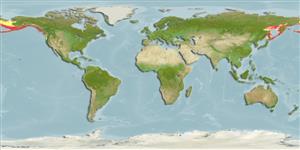>
Perciformes/Cottoidei (Sculpins) >
Hexagrammidae (Greenlings) > Hexagramminae
Etymology: Hexagrammos: Greek, exa = six + greek, gramma = letter,signal (Ref. 45335); stelleri: Named after G.W. Steller, naturalist with C.J. Bering's voyage of discovery (Ref. 6885).
Environment: milieu / climate zone / depth range / distribution range
Ökologie
seewasser demersal; tiefenbereich 0 - 300 m (Ref. 50550). Temperate; 66°N - 42°N
North Pacific: Peter the Great Bay, Russia and the Sea of Japan to Cape Lisburne in the Chukchi Sea, Unimak Island in the Aleutian chain and Oregon, USA.
Size / Gewicht / Alter
Maturity: Lm ? range ? - ? cm
Max length : 48.0 cm TL Männchen/unbestimmt; (Ref. 2850); max. veröff. Gewicht: 1.6 kg (Ref. 27436)
Rückenflossenstacheln (insgesamt): 22 - 25; Rückenflossenweichstrahlen (insgesamt): 19-24; Afterflossenstacheln 0; Afterflossenweichstrahlen: 23 - 25. Caudal slightly forked.
Ranges from the intertidal zone to 175 m depth, possibly to 475 m (Ref. 6793). Found near rocks, pilings and eelgrass beds (Ref. 2850). Feed on worms, crustaceans, and small fishes (Ref. 6885). Neither anterolateral glandular groove nor venom gland is present (Ref. 37773).
Male guards egg mass.
Eschmeyer, W.N., E.S. Herald and H. Hammann, 1983. A field guide to Pacific coast fishes of North America. Boston (MA, USA): Houghton Mifflin Company. xii+336 p. (Ref. 2850)
IUCN Rote Liste Status (Ref. 130435)
Bedrohung für Menschen
Harmless
Nutzung durch Menschen
Fischereien: weniger kommerziell; Sportfisch: ja; Aquarium: Öffentliche Aquarien
Mehr Information
ReferenzenAquakulturAquakultur ProfilZuchtlinienGenetikElectrophoresesVererbbarkeitKrankheitenVerarbeitungNutrientsMass conversion
PartnerBilderStamps, Coins Misc.LauteCiguateraGeschwindigkeitSchwimmstilKiemenoberflächeOtolithsGehirngrößeSehfähigkeit
Tools
Zusatzinformationen
Download XML
Internet Quellen
Estimates based on models
Preferred temperature (Ref.
123201): 1 - 7.9, mean 4 °C (based on 416 cells).
Phylogenetic diversity index (Ref.
82804): PD
50 = 0.5159 [Uniqueness, from 0.5 = low to 2.0 = high].
Bayesian length-weight: a=0.00692 (0.00371 - 0.01290), b=3.16 (2.99 - 3.33), in cm total length, based on LWR estimates for this species & (Sub)family-body (Ref.
93245).
Trophic level (Ref.
69278): 3.4 ±0.42 se; based on food items.
Widerstandsfähigkeit (Ref.
120179): mittel, Verdopplung der Population dauert 1,4 - 4,4 Jahre. (Fec=6,679-38,408).
Fishing Vulnerability (Ref.
59153): Moderate vulnerability (38 of 100).
Nutrients (Ref.
124155): Calcium = 45.3 [20.8, 96.8] mg/100g; Iron = 0.489 [0.223, 1.001] mg/100g; Protein = 17.9 [15.9, 19.9] %; Omega3 = 0.925 [0.413, 2.569] g/100g; Selenium = 18 [10, 42] μg/100g; VitaminA = 17.6 [5.5, 54.6] μg/100g; Zinc = 0.516 [0.351, 0.787] mg/100g (wet weight);
